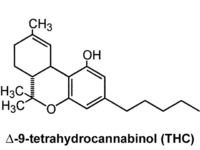The scent of pine from your Christmas tree. The fragrance of a ripe summer peach at the farmer’s market. The whiff of eucalyptus and lavender that greets you when you enter a spa.
Aroma is a keystone in how we experience the world. In any given environment, aroma can help shape your mood, solidify memories and instantly transport you to another place or time.
I have focused my career on studying the fascinating compounds that are often behind these powerful aromas: terpenes. They form the largest class of natural products (compounds produced by living organisms), found in nearly all living beings. There are around 50,000 currently known terpenes in nature — with potentially thousands yet to be discovered.
Terpene-rich plants you might be most familiar with are lavender, mint, oranges (in the peel), and yes, cannabis. In recent years, terpenes have rightfully become a central discussion in the recreational cannabis world. This is because terpenes — not THC level, not “Indica-Sativa” classification — are a key determinant of cannabis’s effect, both psychoactive and non-psychoactive. But the current lack of prioritization and understanding of the crucial role terpenes play may put the collective quality of U.S. cannabis at risk.
 At this crucial inflection point for legal cannabis, on its path to becoming a $70 billion dollar global industry by 2028, we need to ensure that everyone across the cannabis space, from breeders to testers, growers and consumers, understands which traits to prioritize for a cannabis world brimming with diversity and predictable effects.
At this crucial inflection point for legal cannabis, on its path to becoming a $70 billion dollar global industry by 2028, we need to ensure that everyone across the cannabis space, from breeders to testers, growers and consumers, understands which traits to prioritize for a cannabis world brimming with diversity and predictable effects.
What the cannabis industry has to lose
What do we lose if the cannabis industry continues to scale without a clear understanding of the compounds that define the uniqueness of each variety?
There is a ripple effect across the ecosystem. For cannabis testing labs, focusing on only twenty of the most dominant terpenes means we are missing out on tapping into potentially over a hundred of less common terpenes in cannabis. For the cannabis consumer, lack of understanding on the breeding and testing side may make it difficult to find cannabis that delivers on its promised effect time and time again. And, most detrimentally for breeders, not understanding the direct correlation between genetics and the formation of terpenes means we will have increasingly fewer terpene profiles and combinations to work with, especially when the industry-dominant focus has been on cannabinoid potency.
Let’s explore some misconceptions related to potency. In recent years, many breeders have prioritized high THC levels over genetic diversity. Consumers often associate high THC levels and that telltale strong “skunky” aroma with a strain’s quality and effect, when in reality, these are poor indicators of potency. (In fact, recent research indicates that this specific cannabis aroma is caused by a family of sulfur compounds.) Terpene profiling is a much more accurate way to determine a variety’s given effect. In focusing too much on increasing THC, breeders miss out on the true potency powerhouse: tapping into the terpene diversity that’s out there.

To illustrate the impact of breeding practices that prioritize crop yield over product quality, I first have a question for you: When was the last time you enjoyed a really good tomato?
If you’re lucky enough to have a great farmer’s market nearby, maybe you purchased an heirloom tomato at peak freshness last August. It was likely fragrant, flavorful and didn’t need much preparation to be enjoyable.
Or maybe you can’t remember the last time you’ve eaten a good tomato, as the last standard grocery store tomato you purchased was watery, tasteless and essentially scentless.
Tomatoes are a prime example of what is unfortunately true for a whole host of traditional crop plants in the U.S. When yield is the goal, flavor and aroma profiles often suffer. The culprit: lack of genetic diversity in the breeding process. The tragedy of the tomato serves as a harbinger for the cannabis industry — and we can draw parallels to what we’ve seen happen to cannabis.
What the cannabis industry should do: Tap into the diversity that’s out there
An important aspect of preventing cannabis from going the way of the tomato is to better understand the genes that generate these different terpene profiles. Different cultivars with varying aromas will hold different collections of genes. We as an industry must learn more about which terpenes correlate with desirable aromas, and then access already existing genetic diversity.
We have just begun to scratch the surface of the potential of terpenes in cannabis. With the right alignment across the industry and a stronger focus on genetics in breeding, we will see the rise of completely unique cannabis varieties. They will smell like lavender, lilac, orange peel or even brand-new aromas that have yet to be discovered. To ensure this future, we need to prioritize the right traits and the right genetics.










